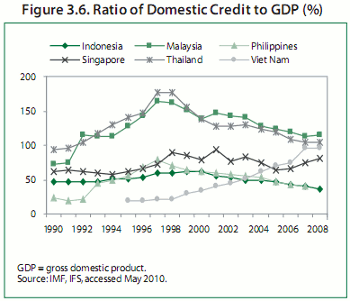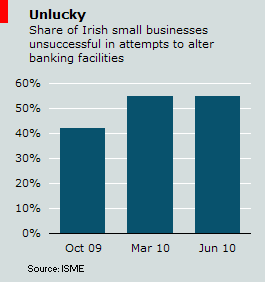You are currently browsing the tag archive for the ‘credit conditions’ tag.
The IMF is worried about overheating in some Latin American economies, thanks to an “excessively stimulative environment”.
 Although the institution is reluctant to label current conditions in the region’s largest markets bubbly, when it comes to credit growth the IMF acknowledges that concerns are rising about whether loan growth is becoming “excessive and eventually unsustainable.” Equity prices are also showing signs of “stretched valuations” in places like Chile, Colombia and Peru.
Although the institution is reluctant to label current conditions in the region’s largest markets bubbly, when it comes to credit growth the IMF acknowledges that concerns are rising about whether loan growth is becoming “excessive and eventually unsustainable.” Equity prices are also showing signs of “stretched valuations” in places like Chile, Colombia and Peru.
Despite being one of the region’s most active users of “macroprudential” measures to cool its economy, Peru stands out from the pack due to its rapid recent credit growth and, especially, sky-high equity valuations.
The Bank of England’s latest “Trends in lending” report paints a subdued picture of credit conditions in the UK. The overall stock of lending continues to fall, particularly for small and medium-sized businesses.

A section of the report on banks’ liabilities, meanwhile, gains extra significance in light of the stubbornly high inflation data released last week. Savers, desperate to keep up with inflation, much less earn real returns, are increasingly squirreling away their money in higher-yielding time deposits with longer maturities. (Guaranteed inflation-beating national savings certificates were recently withdrawn, which makes Buttonwood’s blood boil.)
The share of fixed-rate retail deposits of one year or more has doubled over the past two years. The Economist Intelligence Unit does not expect the Bank of England to raise its policy rate from the all-time low of 0.5% until late this year, prolonging savers’ desperate search for yield for some time to come.
A new report from the Asian Development Bank takes Indonesian banks to task. Or, it is as critical of banks’ lending practices as the rules of international diplomacy will allow. “The efficiency of Indonesia’s domestic financial intermediation is among the lowest in Southeast Asia,” the ADB says.

Indeed, the ratio of domestic credit to GDP in Indonesia is much lower than most of its neighbours. The spread between lending and deposit rates in the country is also wider and more volatile than elsewhere in the region. Although not a “critical constraint to private investment,” as the ADB puts it, more affordable, available credit could help Indonesia more quickly achieve its considerable economic potential.

The latest data on bank loans in Mexico shows a continued improvement in credit conditions. In May, bank credit was 8% up on the year before.
Ignacio Deschamps, president of the Association of Mexican Banks, reckons that lending will grow by double-digits this year. The Economist Intelligence Unit is more cautious, forecasting that loans will rise by around 9% this year and not reach double-digit growth until 2013. Still, as loans through May are on pace for only 4% annualised growth this year, even this more modest expectation suggests a further acceleration in credit growth in the coming months.
The credit-crunch blame game flared up in Ireland today, as a report published by the country’s small-business association brought about an angry response from the national banking association. The Irish Small & Medium Enterprises Association (ISME) released a survey of members that claimed some 55% were refused credit from banks in the last three months. More salaciously, the association said that 12% of survey respondents were asked by banks to consider their family homes as collateral for business loans. With large swathes of the Irish banking system now under government control, the ISME called for an official investigation into “real lending figures”, as opposed to the “fairy tales” it claims are being published in banks’ financial statements.

For its part, the Irish Banking Federation dubbed ISME’s report as “misrepresentative” and “particularly unhelpful” when it comes to promoting corporate confidence. What’s more, the federation added, a government-commissioned report in April showed that one-third of small-business loans were past due, “a key factor in accounting for strains in the supply of credit.” (At the time, the ISME criticised the report as based on “unsubstantiated and incomplete data.”)
If there wasn’t so much at stake, borrowers and lenders could simply agree to disagree and move on.
 As previously discussed, credit conditions remain tight thanks to both supply and demand factors. The European Central Bank’s latest survey of bank loan officers confirms this trend in the euro area. When it comes to their corporate clients, banks continue to report both a net tightening in credit standards and a net decline in loan demand.
As previously discussed, credit conditions remain tight thanks to both supply and demand factors. The European Central Bank’s latest survey of bank loan officers confirms this trend in the euro area. When it comes to their corporate clients, banks continue to report both a net tightening in credit standards and a net decline in loan demand.
Looking ahead, lenders expect net loan demand to turn positive in the current quarter. That said, they had a similarly bullish outlook in the previous quarterly survey and, in the end, were proven wrong by a worsening appetite for loans among corporate borrowers.
The majority of data and analysis at Financial Services Briefing is available only to subscribers. Each week, a small share of content from the service is made available to non-subscribers.
Credit remains crunched. Who is to blame?

The hunt for culprits usually starts with the banks, which stand accused of hoarding cash and shunning creditworthy corporate borrowers. Bankers, in turn, often cite weak loan demand for the ongoing contraction in credit. Surveys, statistics and anecdotal evidence suggest that both supply and demand factors are to blame.
On the bright side, larger companies are taking advantage of improved conditions in the capital markets to raise funds. If banks are unable to extend businesses credit, borrowers may find that others are increasingly willing to stump up cash via other channels.
Read more at Financial Services Briefing: “Supply and demand” (March 30th)
Around half of European banks’ €3.3trn (US$4.5trn) of debt will mature over the next three years, with €550bn coming due this year alone. According to new research from Morgan Stanley, the cost of rolling over this debt will be more expensive than in the recent past.
Concerns about sovereign fiscal health are “increasing the ‘risk’ in the ‘risk-free’ rate,” Morgan Stanley argues. Some €1.6trn in gross government debt issuance this year also risks crowding out private-sector capital. In addition, banks shortened the terms of their borrowing during the financial crisis, so extending maturities will come at a cost. Greater issuance of non-guaranteed debt will also push up costs; in the fourth quarter of last year, government-guaranteed issues fetched spreads 40 basis points lower, on average, than the non-guaranteed variety. Even without widespread hikes in central banks’ policy rates, private-sector lenders’ cost of capital is on the rise.

A recent Bloomberg article notes that American commercial banks are hoarding record amounts of cash in relation to corporate loans. A steady decline in the ratio of cash to business loans—from around 60% in the 1970s to a low of 20% in late 2008—has reversed sharply over the past year. According to Federal Reserve data, banks hoarded an all-time high of 98 cents in cash for every dollar of existing corporate loans during the week of January 13th. The latest reading, for the week of February 3rd, stands at 95 cents.
A combination of weak demand from borrowers and risk aversion from lenders is to blame. In particular, banks are building cash buffers in anticipation of stringent new rules on reserve requirements, leverage ratios and the like. Annual growth in the balance of existing business loans has fallen for eight consecutive months. The credit crunch is far from over.


